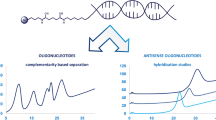Abstract
The preparation of plasmid DNA at large scale constitutes a pressing problem in bioseparation. This paper describes a first investigation of displacement chromatography as a means to separate plasmid DNA (4.7 kb) from E. coli lipopolysaccharides and protein (holo transferrin), respectively. Displacement chromatography has advantages in this regard, since the substance mixture is resolved into rectangular zones of the individual components rather than into peaks. Thus a higher total concentration can be maintained in the pooled product fractions. Hydroxyapatite (type I and II) and anion exchange stationary phases were included in the experiments. In addition to a conventional anion exchange column packed with porous particles, the recently introduced continuous bed UNOTM anion exchange column was investigated. No DNA purification was possible with either hydroxyapatite material. Conventional particle based columns in general were not suited to the separation of any two substances varying considerably in molecular mass, e.g. plasmid DNA and standard protein. Presumably, the direct competition for the binding sites, which is essential in displacement chromatography, was restricted by the size dependency of the accessible stationary phase surface area in this case. Better results were obtained with the continuous bed column, in which the adsorptive surface coincides with the walls of the flow through pores. As a result the accessible surface does not vary as much with the size of the interacting molecules as for the conventional stationary phase materials. Sharper transitions were also observed between substance zones recovered from the UNOTM column. The steric mass action model was used to aid method development in case of the anion exchange approach. While further research in obviously necessary, displacement chromatography on continuous bed columns has been shown to be capable of separating plasmid DNA from typical impurities.
Similar content being viewed by others
References
Antia F and Horvath C (1989) Operational modes of chromatographic separation processes. Ber Bunsenges Phys Chem 93: 961.
Bernardi G (1971) Chromatography of nucleic acids on hydroxyapatite columns. Methods Enzymol 21: 95.
Brooks CA and Cramer SM (1992) Steric mass action ion exchange displacement profiles and induced salt gradients. AIChE J 38: 1969-1978.
Freitag R and Breier J (1995) Displacement chromatography in biotechnological downstream processing. J Chromatogr 691: 101.
Freitag R, Fix M and Brüggemann O (1997) Analysis of endotoxins by capillary electrophoresis. Electrophoresis 18(10): 1899-1905.
Kasper C, Vogt S, Breier J and Freitag R (1996) Protein displacement chromatography in hydroxy-and fluoroapatite columns. Bioseparation 6: 247-262.
Kundu A, Barnthouse KA and Cramer S (1997) Selective displacement chromatography of proteins. Biotech Bioeng 56: 119-129.
Sten RG, MacDonald CG, Weaver AL and Pitt AM (1993) Rapid fluorescence quantitation of plasmid miniprep DNA, BioTechniques 15(5): 932-933.
Vogt S and Freitag R (1997) Comparison of Anion Exchange and Hydroxyapatite Displacement Chromatography for the Isolation of Whey Proteins. J Chromatogr 760: 125-137.
Vogt S and Freitag R (1998) Displacement chromatography using the UNOTM continuous bed column as stationary phase. Biotechnol Progr (submitted).
Author information
Authors and Affiliations
Rights and permissions
About this article
Cite this article
Freitag, R., Vogt, S. Separation of plasmid DNA from protein and bacterial lipopolysaccharides using displacement chromatography. Cytotechnology 30, 159–168 (1999). https://doi.org/10.1023/A:1008091200262
Issue Date:
DOI: https://doi.org/10.1023/A:1008091200262




